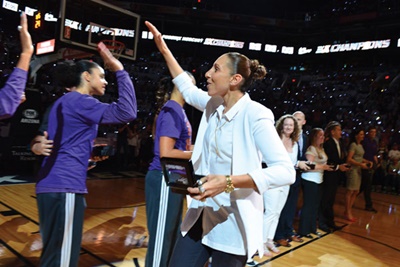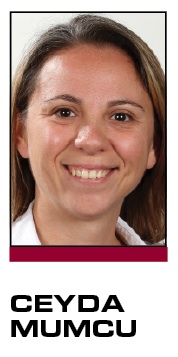The summer of 2015 will be remembered for the many triumphs women’s sport has achieved. With this heightened attention, it may be the opportune time to consider the future of American women athletes and women’s sport. Diana Taurasi’s decision to sit out the 2015 WNBA season was revealed six months ago, and after reviewing the media coverage of her decision and comments on possible impacts to the WNBA, I thought it would be useful to provide some insights on the situation.
In February, Taurasi announced that she would sit out the WNBA season. Considering that Russian team UMMC Ekaterinburg is paying her 15 times more than her WNBA salary, her decision is not surprising. Unfortunately, I believe she will only return to the WNBA when she is nearing retirement. What’s worthy of consideration are the possible implications of Taurasi’s decision on the future of the WNBA. This is not to say this one player’s decision will result in the demise of the league, but it certainly should serve as a warning while also creating some opportunities for the WNBA.
First, it’s important to understand why Ekaterinburg pays Taurasi $1.5 million while the WNBA, the best women’s professional basketball league in the world, can’t. Perhaps the focus should be even broader than just Taurasi, to include why European teams pay WNBA players at least four to five times their WNBA salary. The rationale for this higher pay resides in the competition avenues beyond the domestic leagues, and the structure and the business perspective in Europe.
 |
European competition drives salaries higher for stars like Taurasi.
Photo by: NBAE / GETTY IMAGES
|
In Europe, women’s professional basketball teams have the chance to compete in Euro League and Euro Cup, which are elite-level competitions organized by FIBA, in addition to their domestic leagues. There are 16 teams from 10 countries in the Euro League and 31 teams from 12 countries in the Euro Cup. Although the qualification system varies across countries, in order to compete in these FIBA-organized, club-level elite competitions, teams have to end their domestic leagues in higher ranks. Teams with larger budgets in European leagues want to participate in Euro League and Euro Cup, and the ultimate goal is to become the champion in these elite competitions. Wearing the championship crown of Euro League means prestige, pride and, although not substantial, some additional revenue. Therefore, the major outcome of the Euro League championship is proving dominance beyond national borders and in the continent of Europe, while adding to the tradition of the team. To achieve this high status, European teams loosen the purse strings and offer large salaries to elite WNBA players.
Here, structure of European leagues and the business perspective should be explained. In Europe, women’s basketball teams are not run with business mindset. The goal is to prove dominance in Europe and within domestic leagues, and owners are willing to fund the teams for the prestige and the love of the game, even if it means losing money. In addition, some of the women’s basketball teams are parts of multisport clubs, where several sports from both genders are supported. Usually men’s football drives the business in these clubs and subsidizes women’s basketball and other nonrevenue-generating sports. Lastly, in Europe, there is no salary restriction for athletes or a salary cap for the teams. While elite European and WNBA players earn large sums in salaries, most domestic players make a fraction of these salaries, and this balances out the teams’ budgets.
Looking at the number of teams competing in the Euro League and Euro Cup, one might think this is alarming for the 12-team WNBA. The good news is these European teams are only interested in the very best WNBA players due to the restrictions on the number of foreign players each team can have on their rosters, which in return increases the bargaining power of elite WNBA players and results in large salaries for them. Here the question becomes: If most of the elite WNBA players choose to play for European teams and decide to sit out during the WNBA season, will the quality of the WNBA diminish? If so, what are the likely long-term consequences?
The WNBA should approach this question from the perspective of how it can utilize American athletes as ambassadors of the WNBA in Europe. The goal would be to increase earnings of the WNBA players and league revenue in general. As a former professional basketball player from Turkey, I’ve witnessed the challenges the WNBA players face while playing overseas. The WNBA can support its elite players in their efforts for the well-being of the athletes and the league’s brand. Some of the European teams have deep histories, traditional rivalries and great loyalty to their athletes. This could be leveraged to the WNBA’s advantage.
For example, Angel McCoughtry is well-liked by the Fenerbahce fans in Turkey. Her Turkish fans could be drawn toward WNBA fandom by utilizing strategies such as special apparel, incorporating the Fenerbahce and Atlanta Dream logos, sold in official Fenerbahce stores in Turkey. Also, basketball camps with her name and WNBA affiliation could be organized in Turkey. Although scheduling might be an issue, friendly games between WNBA and Turkish teams could be played to strengthen the WNBA brand in Turkey.
The possibilities are endless. While mainstream leagues such as the NBA and MLB are making efforts to globalize their leagues, the WNBA is missing this opportunity. The WNBA should focus on utilizing its elite athletes playing overseas for the globalization of the league, generating increased revenue for the league and providing new opportunities for their players to stay loyal to the league. Perhaps then, Taurasi and the future players of her caliber would choose to stay in the U.S. and play in the WNBA.
Ceyda Mumcu (CMumcu@newhaven.edu) is an assistant professor for sport management at the University of New Haven.





